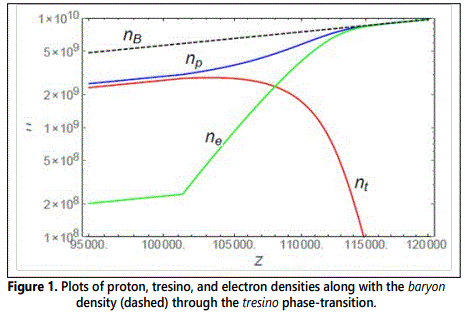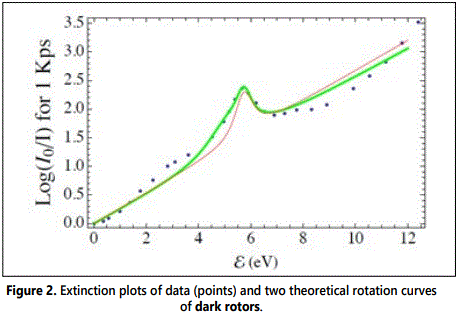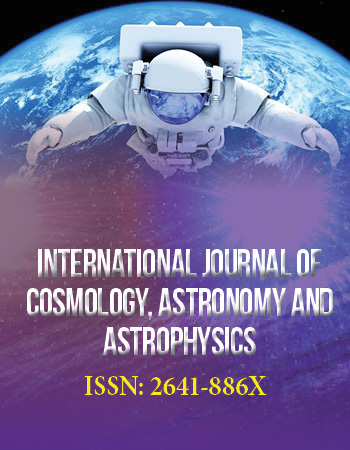Letter to Editor
Cosmic Implications of Tresino Formation: A Narrated Review
Mayer Applied Research Inc., Ann Arbor, MI 48103, USA
*Corresponding author: Frederick J Mayer, Mayer Applied Research Inc. 1417 Dicken Drive, Ann Arbor, MI 48103, USA, E-mail: fmayer@sysmatrix.net
Received: October 27, 2020 Accepted: November 9, 2020 Published: November 13, 2020
Citation: Mayer FJ. Cosmic Implications of Tresino Formation: A Narrated Review. Int J Cosmol Astron Astrophys. 2020; 2(1): 112-114. doi: 10.18689/ijcaa-1000123
Copyright: © 2020 The Author(s). This work is licensed under a Creative Commons Attribution 4.0 International License, which permits unrestricted use, distribution, and reproduction in any medium, provided the original work is properly cited.
Abstract
Tresino formation plays an important role in determining the composition of the universe from late in the early Universe until now. This letter presents a simplified version of our Baryon Phase Transition cosmology to clarify how the composition evolved to become what it is.
Keywords: Cosmic implications; Tresino formation; Baryon Phase Transition.
Introduction
There are still many more questions about the Standard Model of Cosmology (SMC) than have been clearly answered. Alternative theories, like that of my late colleague (John Reitz) and me, donʼt seem to have a chance of even being given an honest reading by cosmologists, let alone being thoughtfully considered. This, even though our theory is unique in that it presents cosmological physics that shows how the two major “dark components” arose and why there are no “missing baryons” only hidden ones. This letter focusses upon these problems and its implications for astrophysical observations.
A Two-Phase Universe
The early paper by Mayer and Reitz [1] presented the tresino phase transition cosmology in its complete form. Much of that paper focussed on the aspects of the theory that emphasized issues that had been considered in the Standard Model of Cosmology (SMC) i.e., the ΛCDM model. Moreover, the paper described how and when the tresino phase transition took place.
In the article by Mayer (2017) [2], it was noted numerous problems with the SMC and compared it to our Baryon Phase Transition model - the model was identified as such because of the tresino phase transition at the heart of the model. (Note: in the present paper, all baryons are considered to be protons, a small but useful idealization) [3].
Figure 1 shows the baryon density changing through the transition from its plasma phase to the new phase where the protons and electrons change into nearly equal numbers of protons and tresinos. (Note: Figure 1 is similar to Figure 4 of the article by Mayer and Reitz [1].) The tresino phase transition takes place over a 200 year period about 200 years after the “big bang”. Interestingly, if no other interactions were to take place, the Universe would then have consisted of tresinos and protons and only a small amount of charge-balanced protons and electrons. But instead, it undergoes another important change as discussed in the next section.

What happens to the Baryons during and after the Tresino Phase-Transition?
It was shown in the article by Mayer FJ [4] that the dynamics of the electrostatic, central-force interaction between tresinos and protons would result in about 25% of them becoming dark rotors; these in turn spin-down to become dark matter and the others continue to expand as “free” protons and “free” tresinos that we identify as dark energy (Section 9 of Mayer, (2015) [4]). So the distribution of baryons may be summarized as follows: two from each dark rotor (one from its tresino and one from its proton) and two more from each escaping proton and tresino pair even though the latter pairs accounts for a larger fraction of the mass energy of the Universe than does the former.
It should be obvious that neither our dark matter particles nor our dark energy pairs will be easy to “find” in the CMB data because of their unique characteristics; however those observers familiar with CMB data reduction might be repaid greatly if they can in fact identify them.
Detecting Dark Matter Particles
The on-going search for a “dark matter” particle in the ΛCDM model has continued now for many years and has failed to either identify or detect such a particle. On the other hand, in the Baryon Phase Transition model, the dark matter particles have been observed for decades but not recognized as such. Specifically, the “extinction” spectrum of the arriving cosmic photons (with its distinctive extinction “bump” at about ≈ 5:7 eV) represents a direct detection as shown in the article by Mayer FJ [4]; it is a result of the rotation of the tresino-proton pairs, i.e., as spun-down rotors. Figure 2 is reproduced from this paper and presents two different (but close) rotation level calculations (the red and green curves) along with the “extinction” data (points). The near-agreement of the rotation model calculations results because the masses of the rotating pairs are exactly those of a proton and a tresino, that is to say, a result of the tresino-transition itself.

However, in the case of dark energy there isnʼt such a simple connection to the Baryon Phase Transition model as was the case for dark matter. Nonetheless, this also was shown to be in agreement with the Baryon Phase Transition model as discussed in the article by Mayer FJ [2] where it is clear that early misinterpretations in the “Assumption of Constant η” (Section 3) led to an under-dense Universe. Here, the problem was that the extrapolation from small η to very large η introduced an error that then produced yet another misinterpretation leading finally to an incorrect assessment of where the remaining mass-energy, required to close the Universe, had to come from. In the Baryon Phase Transition model, the closure results from those tresinos and protons that do not produce rotors, i.e., dark matter in collisions but continue on to form a background of charge-neutral but unconnected pairs of tresinos and protons [4] (Section 9). Notice that this happens somewhat before the later arriving ordinary matter and dark matter during the continuing expansion.
Discussion and Summary
It is interesting that the SMC has neither identified nor detected its “dark matter” particle. Nor has it clearly identified a “dark energy” process (Λ), moreover the SMC simultaneously has a large “missing baryon” problem. On the other hand, our Baryon Phase Transition model has not only identified its dark matter particles (observed in the extinction plots of figure 2) and its dark energy composition. Furthermore it has no “missing baryons” - all the baryons are accounted for in its two dark components. Our model has been “fixed” by the characteristics of the tresino phase-transition as was shown in the Two-Phase Universe approximation presented herein.
The simplification of the Two-Phase Universe makes it clear why the model comparison between the SMC and the Baryon Phase Transition presented was conclusive [2].
References
- Mayer FJ, Reitz JR. Compton Composites Late in the Early Universe. Galaxies. 2014; 2: 382-409. doi: 10.3390/galaxies2030382
- Mayer FJ. The Baryon Phase-Transition Model and the too strange Standard Model of Cosmology. Universe. 2017; 3(1): 18-24. doi: 10.3390/universe3010018
- Mayer FJ. Hidden baryons: The physics of Compton composites. EPL. 2016; 114: 69001-69007. doi: 10.1209/0295-5075/114/69001
- Mayer FJ. Dark rotors in the late universe. Heliyon. 2015; e00039-e00060.


